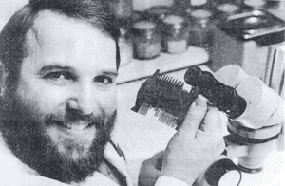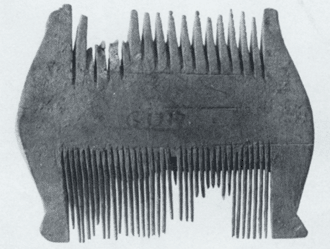|
Ancient head lice on a wooden
comb from AntinoŽ, Egypt*
Seven head lice were recovered from the debris found among the fine teeth of
a wooden comb excavated in AntinoŽ, Egypt, and dated between the fifth and sixth
centuries AD.

Entomologist Ricardo Palma with the
ancient Egyptian comb on which he has found mummified head lice. |
A report by Mumcuoglu and Zias1
on the discovery of head lice on twelve wooden combs excavated in Israel and
dated from the first century BC to the eighth century AD prompted the author to
search for head lice on the only comb of similar type kept in the collections of
the National Museum of New Zealand. This comb was received by the museum in
1914, together with several other archaeological items recovered by the Egypt
Exploration Fund during the excavation of town rubbish mounds in AntinoŽ, Egypt.2
A small amount of reddish-brown dry debris was carefully removed with fine
forceps from among the teeth of the comb; the material from each side was placed
in separate Petri dishes. Ethanol 95% was added to both samples to facilitate
examination under a stereomicroscope. No lice, either whole or broken, were
found in the debris from the coarser side of the comb (2-5 teeth per cm) even
after treating the sample with a 10% aqueous solution of potassium hydroxide (KOH)
for ten minutes at room temperature. However, the debris extracted from the
finer side of the comb (6 teeth per cm) contained the remains of seven specimens
of head lice, either whole bodies or parts of them. These were partially or
totally covered by compacted debris which was dissolved by treatment with KOH as
above. Once cleaned and cleared, the lice were treated with a series of
chemicals, and slide- mounted in Canada Balsam following the technique described
by the author elsewhere.3
Thus, they are now properly preserved and documented for further research.
The seven lice specimens include: one headless male, two partial female
abdomens, one whole late instar nymph, one nymphal abdomen, one whole newly
hatched nymph, and one egg containing a fully developed embryo. The number and
developmental stages listed above fall well within the range of specimens found
by Mumcuoglu and Zias on twelve out of twenty-four combs from the Judean and
Negev Deserts in Israel, i.e. only one egg on a comb from Ein Rachel to twelve
adults/nymphs and twenty-seven eggs on a comb from Qumran, or four nymphs and
eighty-eight eggs on another from Wadi Farah. The effectiveness of fine-toothed
combs as delousing instruments can hardly be overstated. Modern combs differ
very little in shape and dimensions from their ancient counterparts, and they
are still regarded as among the most effective, and indeed the safest, methods
of head lice control.4
|

Wooden comb from AnitnoŽ, Egypt, dated
between the fifth and sixth centuries AD |
The conditions required for the preservation of the comb and the organic
material examined for this study, as well as the circumstances of their burial
and subsequent excavation, are similar to those described by Mumcuoglu and Zias.
These authors wrote that 'Wars forced many Jews to leave urban areas and to
settle in desert caves, where overcrowding and poor hygienic conditions
presumably would encourage parasitic infestations'. This inference may be
correct, but the evidence of the comb from AntinoŽ, a community with a
comparatively more prosperous and peaceful life 5,
suggests that living in more benign circumstances does not necessarily mean a
drastic reduction in head lice infestation. To judge from a recent report by
Maunder the situation does not seem to have changed significantly in the last
2,000 years!
Ricardo L. Palma
*Thanks are due to Mr. Ross O'Rourke (National Museum of New Zealand) for
allowing access to the comb and for all its relevant data; to Professor Robert
L. C. Pilgrim (University of Canterbury) for his critical review of the
manuscript; and to Mr. Mark Strange (National Museum of New Zealand) for the
photograph.
- Y. K. Mumcuoglu and J. Zias, 'Head lice, Pediculus
humanus capitis (Anoplura: Pediculidae) from hair combs excavated in
Israel and dated from the first century B.C. to the eighth century A.D.'
Journal of Medical Entomology 25 (1988),545-7.
- J. de M. Johnson, JEA I (1914), 168-81.
- R. L. Palma, 'Slide-mounting of lice: a detailed
description of the Canada Balsam technique', The New Zealand Entomologist
6 (1978), 432-6.
- J. W. Maunder, 'The appreciation of lice'. Proceedings
of the Royal Institution of Great Britain 55 (1983), 1-31
- Johnson, op. cit.
Reprinted from The Journal of Egyptian Archaeology, Volume
77, 1991 |